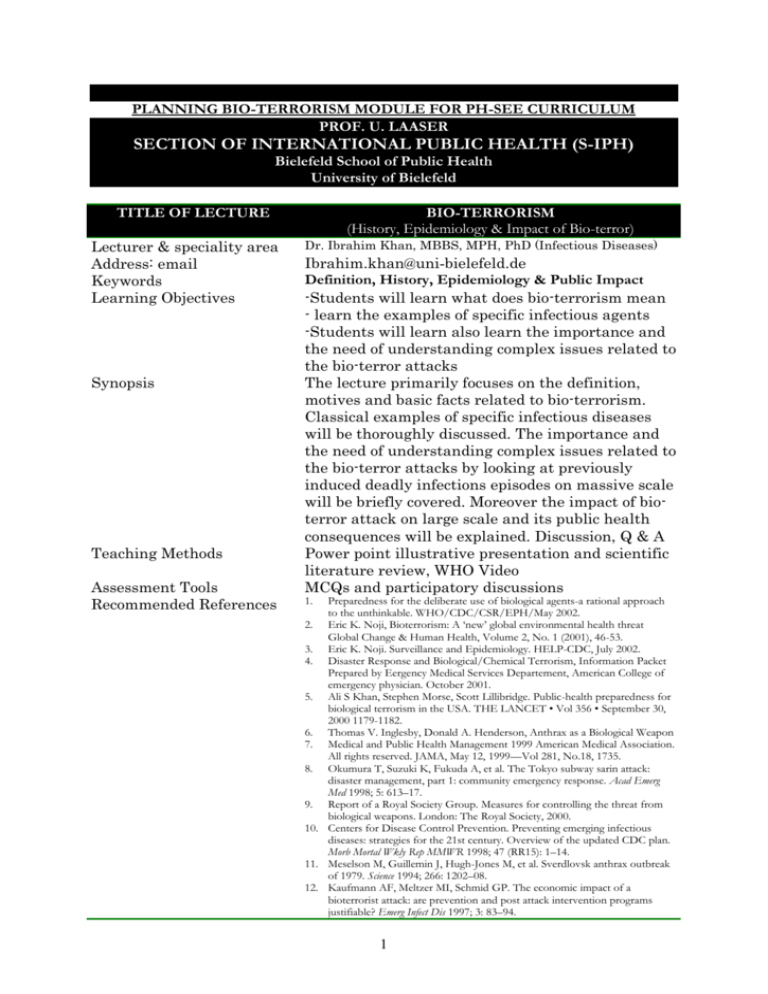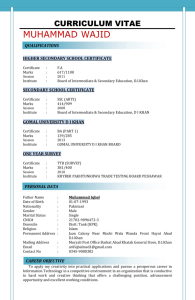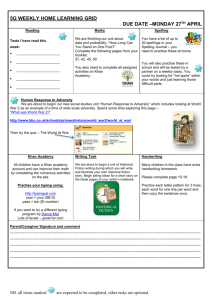
PLANNING BIO-TERRORISM MODULE FOR PH-SEE CURRICULUM
PROF. U. LAASER
SECTION OF INTERNATIONAL PUBLIC HEALTH (S-IPH)
Bielefeld School of Public Health
University of Bielefeld
TITLE OF LECTURE
Lecturer & speciality area
Address: email
Keywords
Learning Objectives
Synopsis
Teaching Methods
Assessment Tools
Recommended References
BIO-TERRORISM
(History, Epidemiology & Impact of Bio-terror)
Dr. Ibrahim Khan, MBBS, MPH, PhD (Infectious Diseases)
Ibrahim.khan@uni-bielefeld.de
Definition, History, Epidemiology & Public Impact
-Students will learn what does bio-terrorism mean
- learn the examples of specific infectious agents
-Students will learn also learn the importance and
the need of understanding complex issues related to
the bio-terror attacks
The lecture primarily focuses on the definition,
motives and basic facts related to bio-terrorism.
Classical examples of specific infectious diseases
will be thoroughly discussed. The importance and
the need of understanding complex issues related to
the bio-terror attacks by looking at previously
induced deadly infections episodes on massive scale
will be briefly covered. Moreover the impact of bioterror attack on large scale and its public health
consequences will be explained. Discussion, Q & A
Power point illustrative presentation and scientific
literature review, WHO Video
MCQs and participatory discussions
1.
Preparedness for the deliberate use of biological agents-a rational approach
to the unthinkable. WHO/CDC/CSR/EPH/May 2002.
2. Eric K. Noji, Bioterrorism: A ‘new’ global environmental health threat
Global Change & Human Health, Volume 2, No. 1 (2001), 46-53.
3. Eric K. Noji. Surveillance and Epidemiology. HELP-CDC, July 2002.
4. Disaster Response and Biological/Chemical Terrorism, Information Packet
Prepared by Eergency Medical Services Departement, American College of
emergency physician. October 2001.
5. Ali S Khan, Stephen Morse, Scott Lillibridge. Public-health preparedness for
biological terrorism in the USA. THE LANCET • Vol 356 • September 30,
2000 1179-1182.
6. Thomas V. Inglesby, Donald A. Henderson, Anthrax as a Biological Weapon
7. Medical and Public Health Management 1999 American Medical Association.
All rights reserved. JAMA, May 12, 1999—Vol 281, No.18, 1735.
8. Okumura T, Suzuki K, Fukuda A, et al. The Tokyo subway sarin attack:
disaster management, part 1: community emergency response. Acad Emerg
Med 1998; 5: 613–17.
9. Report of a Royal Society Group. Measures for controlling the threat from
biological weapons. London: The Royal Society, 2000.
10. Centers for Disease Control Prevention. Preventing emerging infectious
diseases: strategies for the 21st century. Overview of the updated CDC plan.
Morb Mortal Wkly Rep MMWR 1998; 47 (RR15): 1–14.
11. Meselson M, Guillemin J, Hugh-Jones M, et al. Sverdlovsk anthrax outbreak
of 1979. Science 1994; 266: 1202–08.
12. Kaufmann AF, Meltzer MI, Schmid GP. The economic impact of a
bioterrorist attack: are prevention and post attack intervention programs
justifiable? Emerg Infect Dis 1997; 3: 83–94.
1
13. kInglesby TV, Henderson DA, Bartlett JG, et al. Anthrax as a biological
weapon: medical and public health management—working group on civilian
biodefense. JAMA 1999; 281: 1735–45.
TITLE OF LECTURE
Lecturer & speciality area
Address: email
Keywords
Learning Objectives
Synopsis
Teaching Methods
Assessment Tools
Recommended References
BIOLOGICAL AGENTS & PUBLIC HEALTH
CAUSALITIES
Dr. Ibrahim Khan, MBBS, MPH, PhD (Infectious Diseases)
Ibrahim.khan@uni-bielefeld.de
Anthrax, Smallpox, Tularaemia, VHF & Plague
-students will learn five major biological agents and
their respective diseases
-manifestation, recognition, modes of spread
-problems in diagnosis
-students will learn future scenarios if any of these
agents are used in biological attack
-students will learn why are these five agents of
high public health concern?
-students will learn disease specific causalities &
public health impact
This lecture predominantly focuses on five major
biological agents (Anthrax, Smallpox, Tularaemia, VHF &
Plague) that can be or may be used in a bio-terror
attack. Based on the burden of mortality,
morbidity, and disease transmission each agent
and conditions/diseases induced by these agents
will be thoroughly discussed. Problems in detection,
screening and treating such conditions will be a
major theme of the lecture. The lecture will be
followed by participatory discussion (Q& A)
Power point illustrative presentation followed by
review of scientific literature , CDC Video
Participatory discussions and MCQs
1.
Preparedness for the deliberate use of biological agents-a rational approach
to the unthinkable. WHO/CDC/CSR/EPH/May 2002.
2. Eric K. Noji, Bioterrorism: A ‘new’ global environmental health threat
Global Change & Human Health, Volume 2, No. 1 (2001), 46-53.
3. Eric K. Noji. Surveillance and Epidemiology. HELP-CDC, July 2002.
4. Disaster Response and Biological/Chemical Terrorism, Information Packet
Prepared by Eergency Medical Services Departement, American College of
emergency physician. October 2001.
5. Ali S Khan, Stephen Morse, Scott Lillibridge. Public-health preparedness for
biological terrorism in the USA. THE LANCET • Vol 356 • September 30,
2000 1179-1182.
6. Thomas V. Inglesby, Donald A. Henderson, Anthrax as a Biological Weapon
7. Medical and Public Health Management 1999 American Medical Association.
All rights reserved. JAMA, May 12, 1999—Vol 281, No.18, 1735.
8. Okumura T, Suzuki K, Fukuda A, et al. The Tokyo subway sarin attack:
disaster management, part 1: community emergency response. Acad Emerg
Med 1998; 5: 613–17.
9. Report of a Royal Society Group. Measures for controlling the threat from
biological weapons. London: The Royal Society, 2000.
10. Centers for Disease Control Prevention. Preventing emerging infectious
diseases: strategies for the 21st century. Overview of the updated CDC plan.
2
Morb Mortal Wkly Rep MMWR 1998; 47 (RR15): 1–14.
11. Meselson M, Guillemin J, Hugh-Jones M, et al. Sverdlovsk anthrax outbreak
of 1979. Science 1994; 266: 1202–08.
12. Kaufmann AF, Meltzer MI, Schmid GP. The economic impact of a
bioterrorist attack: are prevention and post attack intervention programs
justifiable? Emerg Infect Dis 1997; 3: 83–94.
13. kInglesby TV, Henderson DA, Bartlett JG, et al. Anthrax as a biological
weapon: medical and public health management—working group on civilian
biodefense. JAMA 1999; 281: 1735–45.
TITLE OF LECTURE
Lecturer & speciality area
Address: email
Keywords
Learning Objectives
Synopsis
Teaching Methods
Assessment Tools
Recommended References
SURVEILLANCE, PLANNING & TRIAGE IN THE
TIME OF LARGE SCALE BIO-TERROR EVENT
Dr. Ibrahim Khan, MBBS, MPH, PhD (Infectious Diseases)
Ibrahim.khan@uni-bielefeld.de
Surveillance, Planning & Triage in Bio-terror attack
-Students will learn the epidemiologic approach to
bio-terror attack
-learn the importance and modes of surveillance
-how to plan and conduct triage on a large scale
-learning out break investigation, SEIRV* model
and PICE# staging in case of bio-terror event
With an epidemiologic approach the lecture will cover
issues related to Surveillance, Planning & Triage in a large
scale Bio-terror attack. Keeping resources and facilities of
the health system in mind greater emphasis will be given
how to establish an effective surveillance system,
effectively plan and efficiently manage bio-terror disasters.
Discussion (Q&A)
Power point illustrative presentation followed by
review of scientific literature , CDC Video
Scientific research literature review & MCQs
1.
Preparedness for the deliberate use of biological agents-a rational approach
to the unthinkable. WHO/CDC/CSR/EPH/May 2002.
2. Eric K. Noji, Bioterrorism: A ‘new’ global environmental health threat
Global Change & Human Health, Volume 2, No. 1 (2001), 46-53.
3. Eric K. Noji. Surveillance and Epidemiology. HELP-CDC, July 2002.
4. Disaster Response and Biological/Chemical Terrorism, Information Packet
Prepared by Eergency Medical Services Departement, American College of
emergency physician. October 2001.
5. Ali S Khan, Stephen Morse, Scott Lillibridge. Public-health preparedness for
biological terrorism in the USA. THE LANCET • Vol 356 • September 30,
2000 1179-1182.
6. Thomas V. Inglesby, Donald A. Henderson, Anthrax as a Biological Weapon
7. Medical and Public Health Management 1999 American Medical Association.
All rights reserved. JAMA, May 12, 1999—Vol 281, No.18, 1735.
8. Okumura T, Suzuki K, Fukuda A, et al. The Tokyo subway sarin attack:
disaster management, part 1: community emergency response. Acad Emerg
Med 1998; 5: 613–17.
9. Report of a Royal Society Group. Measures for controlling the threat from
biological weapons. London: The Royal Society, 2000.
10. Centers for Disease Control Prevention. Preventing emerging infectious
diseases: strategies for the 21st century. Overview of the updated CDC plan.
Morb Mortal Wkly Rep MMWR 1998; 47 (RR15): 1–14.
11. Meselson M, Guillemin J, Hugh-Jones M, et al. Sverdlovsk anthrax outbreak
of 1979. Science 1994; 266: 1202–08.
12. Kaufmann AF, Meltzer MI, Schmid GP. The economic impact of a
bioterrorist attack: are prevention and post attack intervention programs
3
justifiable? Emerg Infect Dis 1997; 3: 83–94.
13. kInglesby TV, Henderson DA, Bartlett JG, et al. Anthrax as a biological
weapon: medical and public health management—working group on civilian
biodefense. JAMA 1999; 281: 1735–45.
* SEIRV model, S-susceptible, E-exposed, I-infections, R-removed, V-vaccinated
# PICE staging- Potential of injury/illness creating event
TITLE OF LECTURE
Lecturer & speciality area
Address: email
Keywords
Learning Objectives
Synopsis
Teaching Methods
Assessment Tools
Recommended References
PHYSICIAN, PUBLIC HEALTH, HOSPITAL &
COMMUNITY PREPAREDNESS FOR BIOTERROR
Dr. Ibrahim Khan, MBBS, MPH, PhD (Infectious Diseases)
Ibrahim.khan@uni-bielefeld.de
Physician, Public Health, Hospital Preparedness
-Students will learn the expected roles &
responsibilities of physicians, public health experts
and hospitals in terms of managing the victims of
biological disaster
-students will learn what public needs to know in
such events and personal safety issues
The lecture focuses on crucial issues related to
biological disasters and terror attacks. It discusses
the level of physician’s knowledge about rare
diseases, practices and advance techniques for
detecting, treating infected patients while rescuing
them. The lecture also focuses the issues of
disinfections and public awareness and community
dynamics and environmental issues by using media
and other technologies. Discussion and Q&A
Power point illustrative presentation followed by
review of scientific literature , CDC Video
Group presentations
1.
Preparedness for the deliberate use of biological agents-a rational approach
to the unthinkable. WHO/CDC/CSR/EPH/May 2002.
2. Eric K. Noji, Bioterrorism: A ‘new’ global environmental health threat
Global Change & Human Health, Volume 2, No. 1 (2001), 46-53.
3. Eric K. Noji. Surveillance and Epidemiology. HELP-CDC, July 2002.
4. Disaster Response and Biological/Chemical Terrorism, Information Packet
Prepared by Eergency Medical Services Departement, American College of
emergency physician. October 2001.
5. Ali S Khan, Stephen Morse, Scott Lillibridge. Public-health preparedness for
biological terrorism in the USA. THE LANCET • Vol 356 • September 30,
2000 1179-1182.
6. Thomas V. Inglesby, Donald A. Henderson, Anthrax as a Biological Weapon
7. Medical and Public Health Management 1999 American Medical Association.
All rights reserved. JAMA, May 12, 1999—Vol 281, No.18, 1735.
8. Okumura T, Suzuki K, Fukuda A, et al. The Tokyo subway sarin attack:
disaster management, part 1: community emergency response. Acad Emerg
Med 1998; 5: 613–17.
9. Report of a Royal Society Group. Measures for controlling the threat from
biological weapons. London: The Royal Society, 2000.
10. Centers for Disease Control Prevention. Preventing emerging infectious
diseases: strategies for the 21st century. Overview of the updated CDC plan.
Morb Mortal Wkly Rep MMWR 1998; 47 (RR15): 1–14.
11. Meselson M, Guillemin J, Hugh-Jones M, et al. Sverdlovsk anthrax outbreak
of 1979. Science 1994; 266: 1202–08.
12. Kaufmann AF, Meltzer MI, Schmid GP. The economic impact of a
4
bioterrorist attack: are prevention and post attack intervention programs
justifiable? Emerg Infect Dis 1997; 3: 83–94.
13. kInglesby TV, Henderson DA, Bartlett JG, et al. Anthrax as a biological
weapon: medical and public health management—working group on civilian
biodefense. JAMA 1999; 281: 1735–45.
TITLE OF LECTURE
Lecturer & speciality area
Address: email
Keywords
Learning Objectives
Synopsis
Teaching Methods
Assessment Tools
Recommended References
USEFUL INFORMATION SOURCES ON BIOTERRORISM (INTRODUCTION & PRACTICE)
Dr. Ibrahim Khan, MBBS, MPH, PhD (Infectious Diseases)
Ibrahim.khan@uni-bielefeld.de
Books, articles and internet sources of info
-students will learn how to utilize the info on the
issue
This session of internet projection on the screen
will show the important website info from CDC,
WHO, Robert Koch Institute.
Text books of British Royal society on the subjects
Literature on Guidelines and safety measures for
public health students
Instructions, mutual discussions and power point
presentation
Teach & Practice
1.
Preparedness for the deliberate use of biological agents-a rational approach
to the unthinkable. WHO/CDC/CSR/EPH/May 2002.
2. Eric K. Noji, Bioterrorism: A ‘new’ global environmental health threat
Global Change & Human Health, Volume 2, No. 1 (2001), 46-53.
3. Eric K. Noji. Surveillance and Epidemiology. HELP-CDC, July 2002.
4. Disaster Response and Biological/Chemical Terrorism, Information Packet
Prepared by Eergency Medical Services Departement, American College of
emergency physician. October 2001.
5. Ali S Khan, Stephen Morse, Scott Lillibridge. Public-health preparedness for
biological terrorism in the USA. THE LANCET • Vol 356 • September 30,
2000 1179-1182.
6. Thomas V. Inglesby, Donald A. Henderson, Anthrax as a Biological Weapon
7. Medical and Public Health Management 1999 American Medical Association.
All rights reserved. JAMA, May 12, 1999—Vol 281, No.18, 1735.
8. Okumura T, Suzuki K, Fukuda A, et al. The Tokyo subway sarin attack:
disaster management, part 1: community emergency response. Acad Emerg
Med 1998; 5: 613–17.
9. Report of a Royal Society Group. Measures for controlling the threat from
biological weapons. London: The Royal Society, 2000.
10. Centers for Disease Control Prevention. Preventing emerging infectious
diseases: strategies for the 21st century. Overview of the updated CDC plan.
Morb Mortal Wkly Rep MMWR 1998; 47 (RR15): 1–14.
11. Meselson M, Guillemin J, Hugh-Jones M, et al. Sverdlovsk anthrax outbreak
of 1979. Science 1994; 266: 1202–08.
12. kInglesby TV, Henderson DA, Bartlett JG, et al. Anthrax as a biological
weapon: medical and public health management—working group on civilian
biodefense. JAMA 1999; 281: 1735–45.
5
INTERNATIONAL ENVIRONMENT HEALTH
PROF. U. LAASER
SECTION OF INTERNATIONAL PUBLIC HEALTH (S-IPH)
Bielefeld School of Public Health
University of Bielefeld
TITLE OF LECTURE
Lecturer & speciality area
Address: email
Keywords
Learning Objectives
Synopsis
Teaching Methods
Assessment Tools
Recommended References
RADIATION ACCIDENTS, EMERGENCIES &
PREPAREDNESS
Dr. Ibrahim Khan, MBBS, MPH, PhD (Infectious Diseases)
Ibrahim.khan@uni-bielefeld.de
Radiation Accidents, Emergencies, REMPAN
-students will learn global environmental issues that cause
massive causalities e.g., in case of radiation disaster
-students will learn the role of environmental sciences in
prevention and limiting diseases and disabilities
-WHO Strategies that deal with global environmental issues
The lecture provide vital facts and insights into the issues
environmental disasters, depleted uranium, sources, exposure
and health impacts. Taking the example of Chernobyl disaster
the lecture provides a brief overview of WHO strategies and
preventive efforts by discussing the mission of REMPANRadiation Emergency Preparedness & Assistance Network.
The lecture covers also the modalities for protecting future
human environment.
Power point presentation, discussions and Q&A
Literature review and MCQs test
1.
2.
3.
4.
5.
Protection of the humn environment. Health consequences of the
Chernobyle accidents. Results of the IPHECA pilot projects & related
national programes. WHO summary report, 1995.
(www.who.int/peh/Radiation/Chernobyl.htm)
International –Program on chemical safety, Global assessment of the state of
the science of endocrine disrupters.WHO/PCS/EDC/02.2.
Water & sanitation.(www.who.int/water-sanitation-health)
Health Waste management.
WHO/News/sitemap/HTPBCThome/BTS/QSD/DIL/DCT
Chemical incidents & Emergencies. Role & responses of WHO & IPCS.
(www.who.int/pcs/chem-incid-site/chem-incid-
emerg.html)
6. www.intox.org
7. www.opcw.org
8. www.inchem.org
6
TITLE OF LECTURE
Lecturer & speciality area
Address: email
Keywords
Learning Objectives
Synopsis
Teaching Methods
Assessment Tools
Recommended References
HEALTH WASTE MANAGEMENT
Dr. Ibrahim Khan, MBBS, MPH, PhD (Infectious Diseases)
Ibrahim.khan@uni-bielefeld.de
Waste, management,biological, chemical & nuclear
-students will learn what is health waste
management, global facts and figures
-students will learn the difficulties of disposal and
implication of biological, chemical and nuclear
waste material on human health
-students will learn WHO Policy and strategies
The lecture focuses on the problem of health waste
management of biological, chemical & nuclear
nature, its global impact public health and threats
for future generations. Discussing countries case
studies, the lecture emphasises on focusing on local
solutions for global problem and provide a brief
account of the initiative of Devices & Clinical
Technology (DCT).
Power point presentations, group discussion, Q&A
Group Presentation on selected problems
1.
2.
3.
4.
International –Program on chemical safety, Global assessment of the state of
the science of endocrine disrupters.WHO/PCS/EDC/02.2.
Water & sanitation.(www.who.int/water-sanitation-health)
Health Waste management.
WHO/News/sitemap/HTPBCThome/BTS/QSD/DIL/DCT
Chemical incidents & Emergencies. Role & responses of WHO & IPCS.
(www.who.int/pcs/chem-incid-site/chem-incid-
emerg.html)
5.
Protection of the humn environment. Health consequences of the
Chernobyle accidents. Results of the IPHECA pilot projects & related
national programes. WHO summary report, 1995.
(www.who.int/peh/Radiation/Chernobyl.htm)
www.intox.org
www.opcw.org
8. www.inchem.org
6.
7.
7
TITLE OF LECTURE
Lecturer & speciality area
Address: email
Keywords
Learning Objectives
Synopsis
Teaching Methods
Assessment Tools
Recommended References
EXPOSURE TO ENDOCRINE DISRUPTERS
(EDCs)
Dr. Ibrahim Khan, MBBS, MPH, PhD (Infectious Diseases)
Ibrahim.khan@uni-bielefeld.de
exposure, endocrine disrupters (EDCs)
-students will learn what are endocrine disrupters
- learn facts and figure and public health impact
- learn WHO & strategies and case reports
The lecture provides insights into the long globally
neglected problem i.e., endocrine disrupters (EDCs)
which is related to naturally occurring and
synthetic substances, plastic materials, pesticides,
monomers, breakdown products and persistent
environmental pollutants to which millions of
people and specially children are exposed to. The
lecture illustrates various international policies
and actions taken against the hazardous
substances for instance, substance control Act-1976
and international program on chemical safety
(IPCS).
Power point presentation, Group discussions, Q&A
Scientific literature review & group presentation
1.
2.
3.
4.
International –Program on chemical safety, Global assessment of the state of
the science of endocrine disrupters.WHO/PCS/EDC/02.2.
Water & sanitation.(www.who.int/water-sanitation-health)
Health Waste management.
WHO/News/sitemap/HTPBCThome/BTS/QSD/DIL/DCT
Chemical incidents & Emergencies. Role & responses of WHO & IPCS.
(www.who.int/pcs/chem-incid-site/chem-incid-
emerg.html)
5.
Protection of the humn environment. Health consequences of the
Chernobyle accidents. Results of the IPHECA pilot projects & related
national programes. WHO summary report, 1995.
(www.who.int/peh/Radiation/Chernobyl.htm)
www.intox.org
www.opcw.org
8. www.inchem.org
6.
7.
8
TITLE OF LECTURE
Lecturer & speciality area
Address: email
Keywords
Learning Objectives
Synopsis
Teaching Methods
Assessment Tools
Recommended References
BIOLOGICAL EVOLUTION AND PUBLIC
HEALTH CHALLENGES (VIDEO)
Dr. Ibrahim Khan, MBBS, MPH, PhD (Infectious Diseases)
Ibrahim.khan@uni-bielefeld.de
Microbes, evolution, resistance, infections
-students will learn what does evolution mean and
-what are biological and ecological diversities ?
-students will learn how it takes place and its
public health consequences and challenges in
infection control
The lecture provides a comprehensive review of the
concept of biological evolution and the reasons that
provide a greater impetus to the process of
biological evolution. Briefly reviewing those
biological agents which cause lethal and serious
infections among human population. Taking the
case of multiple drug resistance (MDR), considering
the highest mortality and morbidity figures, the
lecture provides insights into to the crucial issue of
rapidly emerging resistant tuberculosis on global
level and its impact of health system. In order to
deal with this threatening issue the lecture
categorically addresses all vital aspects and
discusses the matter of competent management
and prevention with public health perspective.
Power point presentation, group discussion, video
demonstration
Review of Scientific research literature, Q&A and
MCQs test
1.
2.
3.
4.
5.
6.
7.
8.
Dye C, Williams BG, Espinal MA, Raviglione MC. Erasing the world's
slow stain: strategies to beat multidrug-resistant tuberculosis. Science
2002;295:2042-6.
Khan IM, Laaser U.Resistance and refugees in Pakistan: challenges ahead
in tuberculosis control. Lancet Infect Dis. 2002 May;2(5):270-2.
Khan IM, Yassin KM, Hurrelmann K, Laaser U.Urging health system
research: identifying gaps and fortifying tuberculosis control in Pakistan.
Croat Med J. 2002 Aug;43(4):480-4.
Khan, I.M., U. Laaser. Burden of Tuberculosis in Afghanistan: Update
on a War-stricken Country. Croatian Medical Journal 43/2 (2002), 245247.
Pablos-Mendez A, Gowda DK, Frieden TR.Controlling multidrugresistant tuberculosis and access to expensive drugs: a rational
framework. Bull World Health Organ. 2002;80(6):489-95; discussion 495500.
World Health Organisation. Anti-tuberculosis drug resistance in the
world: the WHO/IUATLD global project on anti-tuberculosis drug
resistance surveillance 1994-7. Geneva; WHO 1997.
WHO Report 2002.Global Tuberculosis Control: Surveillance, Planning,
Financing WHO/CDS/TB/2002.295.
WHO Global DOTS expansion plan, program in the TB control in high
burden countries, WHO/CDS/2001
9
TITLE OF LECTURE
Lecturer & speciality area
Address: email
Keywords
Learning Objectives
Synopsis
Teaching Methods
Assessment Tools
Recommended References
FOOD & WATER BORN INFECTIONS &
INTOXICATIONS
Dr. Ibrahim Khan, MBBS, MPH, PhD (Infectious Diseases)
Ibrahim.khan@uni-bielefeld.de
Food borne infections, environment, prevention
-students will learn important food & water born
diseases and intoxication states
-preventive measures and food security issues
This lecture focuses on food related outbreaks in
which environment have a key role. Discussing the
examples of salmonella and Giardia etc. the
content, facts and medical evidences provide a
comprehensive overview of transmission nodes that
can play a pivotal role in improving as well as
securing community health. Surveillance and
management aspects in outbreak situation are
thoroughly discussed.
Power point presentation, group discussion
Literature review, Q&A and MCQs
1. Water & sanitation.(www.who.int/water-sanitation-health)
2.
3.
4.
5.
6.
7.
Törörk TJ, Tauxe RV, Wise RP, et al. A large community outbreak of
Salmonellosis caused by intentional contamination of restaurant salad bars.
JAMA 1997; 278: 389–95.
Stephenson J. New approaches for detecting and curtailing foodborne
microbial infections. JAMA 1997; 277: 1337, 1339–40.
Protection of the humn environment. Health consequences of the
Chernobyle accidents. Results of the IPHECA pilot projects & related
national programes. WHO summary report, 1995.
(www.who.int/peh/Radiation/Chernobyl.htm)
International –Program on chemical safety, Global assessment of the state of
the science of endocrine disrupters.WHO/PCS/EDC/02.2.
Health Waste management.
WHO/News/sitemap/HTPBCThome/BTS/QSD/DIL/DCT
Chemical incidents & Emergencies. Role & responses of WHO & IPCS.
(www.who.int/pcs/chem-incid-site/chem-incid-
emerg.html)
10
TITLE OF LECTURE
Lecturer & speciality area
Address: email
Keywords
Learning Objectives
Synopsis
Teaching Methods
Assessment Tools
Recommended References
ENVIRONMENTAL HAZARDS & RESPIRATORY
INFECTIONS
Dr. Ibrahim Khan, MBBS, MPH, PhD (Infectious Diseases)
Ibrahim.khan@uni-bielefeld.de
Environment, hazards, respiratory infections
-students will learn the role of environment in
diseases induction and progression in human
pollution
-students will learn particularly on respiratory
infections and allergies and coping strategies as
environmental and public health experts
The lecture focuses on the epidemiology, burden of outdoor
and indoor pollution and environment induced diseases and
disorders. It discusses briefly the impact on susceptible
communities in developing countries by taking the example
of chronic obstructive pulmonary diseases (COPD) &
reviews the applicability and adoptability of Global Initiative
for chronic Obstructive Lung Diseases (GOLD) Strategy.
Power Point Presentation, Group discussion,
scientific literature review
Case studies and Q&A and MCQs
1.
2.
3.
4.
Protection of the humn environment. Health consequences of the
Chernobyle accidents. Results of the IPHECA pilot projects & related
national programes. WHO summary report, 1995.
(www.who.int/peh/Radiation/Chernobyl.htm)
International –Program on chemical safety, Global assessment of the state of
the science of endocrine disrupters.WHO/PCS/EDC/02.2.
Health Waste management.
WHO/News/sitemap/HTPBCThome/BTS/QSD/DIL/DCT
Chemical incidents & Emergencies. Role & responses of WHO & IPCS.
(www.who.int/pcs/chem-incid-site/chem-incid-
emerg.html)
5. www.intox.org
6. www.opcw.org
7. www.inchem.org
11








